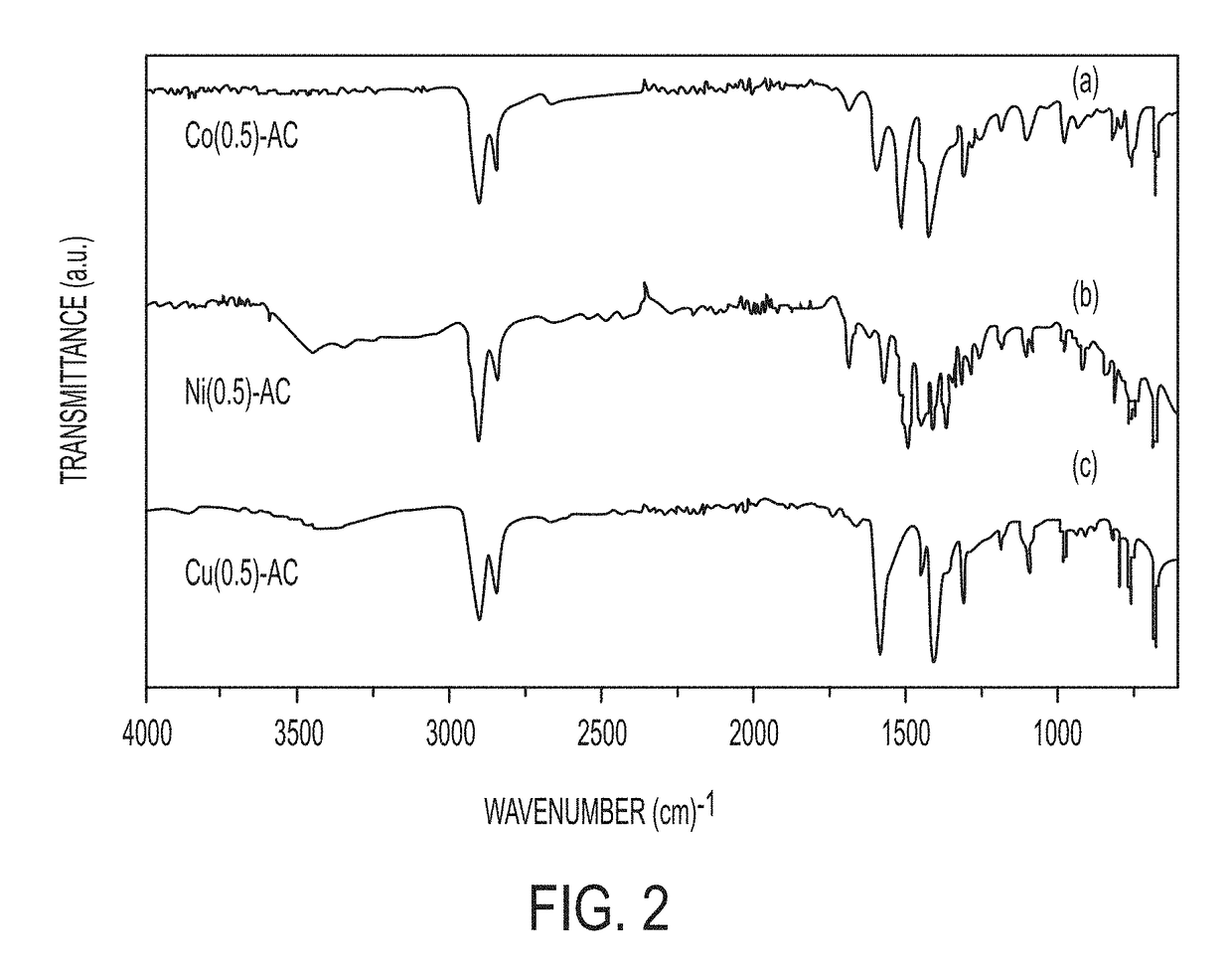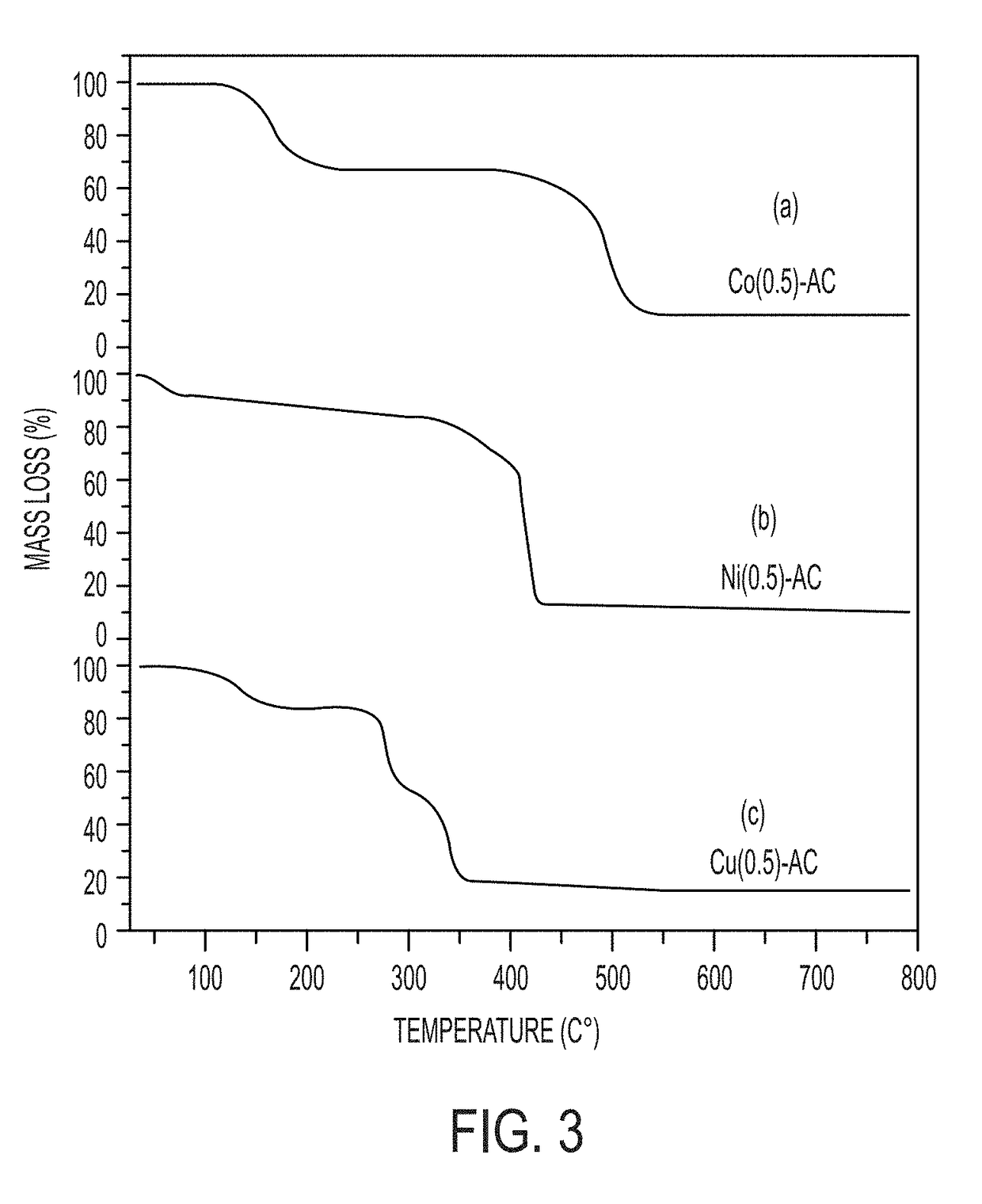Synthesis of transition-metal adamantane salts and oxide nanocomposites, and systems and methods including the salts or the nanocomposites
a technology of transition-metal adamantane salts and oxide nanocomposites, which is applied in the field of transition-metal diamondoid salts and nanocomposites, can solve the problems of impurities arising from diffusion length barriers and cumbersome high-temperature solid-state synthesis
- Summary
- Abstract
- Description
- Claims
- Application Information
AI Technical Summary
Benefits of technology
Problems solved by technology
Method used
Image
Examples
example 1
Synthesis and Characterization of Cobalt Adamantanes
[0091]Co-adamantane carboxylate salts (Co-AC) were synthesized by treating Co(OH)2 and 1-adamantane carboxylic acid (ACA) under hydrothermal conditions at 110° C. for 24 h. Prior to the reaction, the reactants were intimately mixed by stirring for 1 h using a magnetic stirrer. Two Co-AC compounds were synthesized with different molar ratios of Co2+ to ACA to evaluate the effects of supersaturation on phase formation and the morphology of the resultant phase. A first compound, Co(0.5)-AC, was synthesized using a 0.5 molar ratio of Co2+ to ACA. A second compound, Co(1.0)-AC, was synthesized using a 1.0 molar ratio of Co2+ to ACA. The compounds were characterized using various analytical techniques.
[0092]The PXRD pattern of Co(0.5)-AC is provided as spectrum (a) of FIG. 1. Low angle reflections were observed at 2θ angles of 4.27°, 6.08°, 6.65°, 7.50°, 9.31°, and 10.91°. These low-angle reflections indicate d-spacings of 20.67 Å, 14.52...
example 2
Cobalt Oxide from Thermal Decomposition of Cobalt Adamantane Carboxylate Salts
[0100]The Co(0.5)-AC, on calcination is expected to give Co3O4 / CoO supported on the carbon residue of adamantane. Co(0.5)-AC prepared according to Example 1 was decomposed at 450° C. for 4 h under air atmosphere.
[0101]The PXRD of the resultant oxide material is provided as plot (b) of FIG. 1. The PXRD showed reflections at 2θ angles of 19.23°, 31.63°, 37.13°, 38.9°, 45.1°, 55.91°, and 59.63°. These reflections indicate d-spacings of 4.61 Å, 2.82 Å, 2.41 Å, 2.31 Å, 2.0 Å, 1.64 Å and 1.54 Å, respectively. The reflections of the prepared sample were determined to be more consistent with literature reports of Co3O4 rather than of CoO. A broad hump centered around 14° in the PXRD of the oxide sample could not be assigned to any phase of cobalt oxide. The origin of this broad hump is believed to arise from residual carbon present in the sample that creates a layered material.
[0102]The oxide residue of Co(0.5)-AC...
example 3
Synthesis and Characterization of Nickel Adamantane Carboxylate Salts
[0105]Ni-adamantane carboxylate (Ni-AC) was synthesized by treating Ni(OH)2 and 1-adamantane carboxylic acid in a 0.5:1 molar ratio of Ni2+ to ACA, under hydrothermal conditions at 150° C. for 24 h. Prior to the reaction, the reactants were intimately mixed by stirring for 1 h using a magnetic stirrer. The resultant material, Ni(0.5)-AC, was characterized by PXRD, IR, TGA, and SEM.
[0106]The PXRD spectrum of Ni(0.5)-AC in plot (a) of FIG. 7 exhibited a series of low-angle reflections at 2θ angles of 5.33°, 6.11°, 6.32°, and 7.87°. These low-angle reflections indicated d-spacings of 16.56 Å, 14.45 Å, 13.97 Å, and 13.06 Å, respectively. The low-angle reflections showed second submultiples at 8.30 Å, 7.97 Å, 7.34 Å, and 6.48 Å. The PXRD also exhibited higher submultiples of the low-angle reflections at higher 2θ values. The appearance of the submultiples is consistent with Ni-AC having crystallized in a layered structu...
PUM
| Property | Measurement | Unit |
|---|---|---|
| temperature | aaaaa | aaaaa |
| temperature | aaaaa | aaaaa |
| reaction temperature | aaaaa | aaaaa |
Abstract
Description
Claims
Application Information
 Login to View More
Login to View More - R&D
- Intellectual Property
- Life Sciences
- Materials
- Tech Scout
- Unparalleled Data Quality
- Higher Quality Content
- 60% Fewer Hallucinations
Browse by: Latest US Patents, China's latest patents, Technical Efficacy Thesaurus, Application Domain, Technology Topic, Popular Technical Reports.
© 2025 PatSnap. All rights reserved.Legal|Privacy policy|Modern Slavery Act Transparency Statement|Sitemap|About US| Contact US: help@patsnap.com



